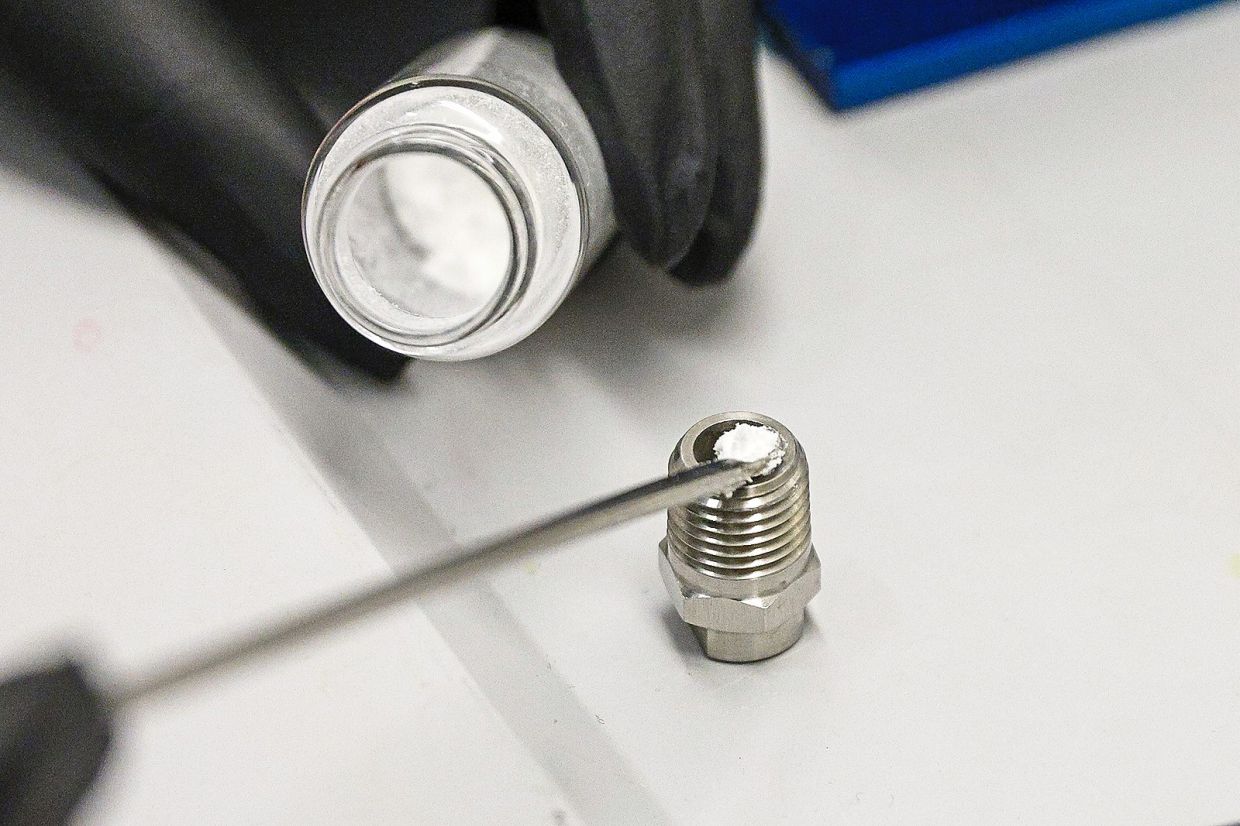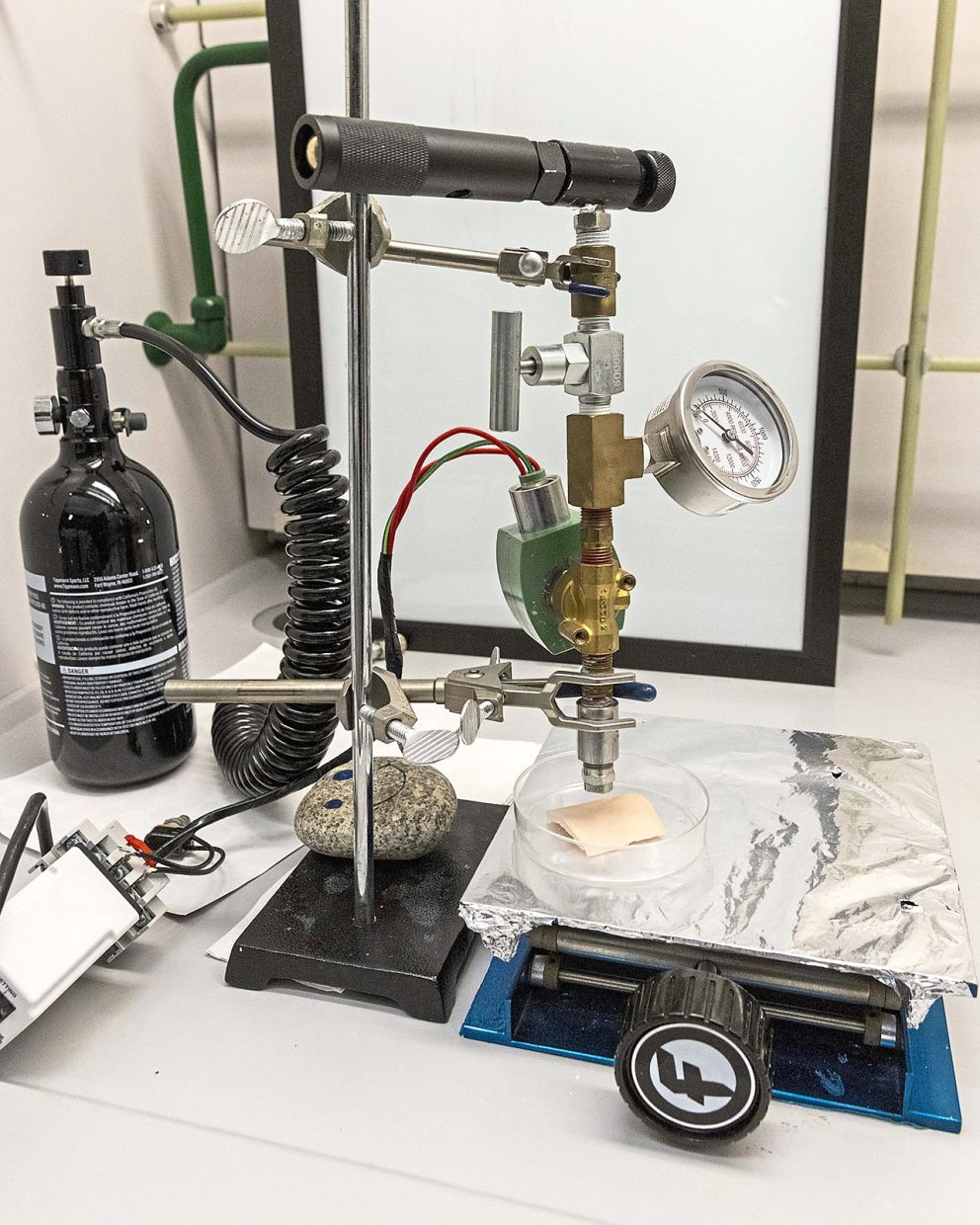Wijesundara (left) and her fellow graduate student Sneha Kumari stand next to the MOF-jet in their lab at UTD. — Photos: TNS
Yalini Wijesundara stared at the air gun sitting in her lab.
Her lab director, Associate Professor Dr Jeremiah Gassensmith, had built it in a spur of pandemic-induced boredom, shooting table salt around his home office.
Once lockdown ended, he brought it to his biochemistry lab and asked Wijesundara to find a research purpose for it.
The then-first-year graduate student at the University of Texas at Dallas (UTD) in the United States, had just moved to Texas from Sri Lanka.
She felt like a fish out of water, still figuring out how the lab worked.
Take your time, Assoc Prof Gassensmith told her, you’ll figure it out.
Two years later, Wijesundara cracked the code.
She brought new life to the old air gun, creating a system to deliver vaccines with a puff of gas.
It’s less painful than traditional needle vaccines, Wijesundara said, comparable to being hit by a Nerf bullet.
The research was published in the journal Chemical Science last year (2022).
There’s a long way to go before people can receive gas-puff vaccines, but Wijesundara and Assoc Prof Gassensmith are committed to creating a less-scary way to deliver life-saving medicines.
“We need to move the field forward in our ability to make vaccination as painless ... as possible,” the latter said.
A ‘therapeutic bullet’
Before moving to Texas, Wijesundara studied metal-organic frameworks (MOFs) at the University of Peradeniya in Sri Lanka.
MOFs are metal ions and stick-like organic molecules that, like Tinkertoys, come together to build complex cages.
These cages can hold gasses, proteins, and even DNA.
When selecting a doctoral programme, Wijesundara saw that Assoc Prof Gassensmith’s chemistry lab at UTD designed MOF “cages” to hold powdered, shelf-stable vaccines.
It was a perfect fit.
Considering the air gun, she wondered if it could propel the powdered vaccines into people.
She dove into the history of vaccines and found that high-pressure vaccine injectors became popular in the 1950s.
These injectors used a high-speed stream of liquid to propel vaccines through the skin.
However, not only were these liquid injectors painful, but body fluids could also squirt back onto the injector nozzles, promoting the spread of bloodborne infectious diseases like hepatitis B and C.
“[I realised] we can solve that problem,” she said, “because we are using a solid [vaccine] that has zero spray-back problems.”
Wijesundara figured out the ideal pressure and distance from the skin to propel a vaccine with the air gun, which she modified to create the “MOF-jet”.
She used a MOF that contains zinc – a mineral found throughout the body – to carry the vaccine.
She also tweaked the gun’s nozzle to hold the vaccine until injection.
With a push of a button, the MOF-jet’s valve quickly opens and closes, shooting out a vaccine “bullet” inside a zinc cage.
Once the cage enters the skin, salts in our skin fluids pull the cage apart, releasing the vaccine.
Controlled release
Wijesundara and Assoc Prof Gassensmith tested the MOF-jet on plant cells and mice with a protein commonly used in vaccine experiments.
During the tests, they discovered another useful property of the MOF-jet.
When the vaccine was propelled through the skin using an acidic gas like carbon dioxide, the zinc cage quickly dissolved and released its contents over 24 hours.
But when they used a more neutral gas like air, the cage broke down slowly over one to two weeks.
“You can effectively control whether or not you want the medicine right now, or you want the medicine slowly released over a period of time,” Assoc Prof Gassensmith said.
Many research teams are exploring new ways to deliver drugs and vaccines, according to Dr Tim Corcoran, an associate professor of bioengineering at the University of Pittsburgh Medical Center in the US.
Transdermal patches that can transfer medication through the skin and ultrathin “microneedles” are two of the methods being studied.
Although Wijesundara and Assoc Prof Gassensmith’s research is in the early stages, Assoc Prof Corcoran, who was not involved with the research, said that the design of the MOF particles and timed release of their contents adds something new to the field.
“The concept of being able to really control the little therapeutic bullet, and make that do exactly what you want, is really the novelty here,” he said.
No more needles
Assoc Prof Gassensmith said the MOF-jet could be used to inject flu and Covid-19 vaccines, as well as some diabetes drugs and allergy shots.
The MOF-jet cannot inject drugs that need to work immediately, like emergency room drugs.
It’s a long way from being used at the doctor’s office and has yet to be tested on humans, aside from Assoc Prof Gassensmith trying it on himself in the lab.
They also need to convert the clunky prototype into an easy-to-use device.
“It looks like something you’d find in an auto shop, not something in the doctor’s office,” he said.
Wijesundara is exploring whether the MOF-jet could deliver treatments for melanoma, a type of skin cancer.
The MOFs could distribute treatments more evenly throughout the body compared to a needle, and doctors could time the release of the medicines.
The early days working on this project were challenging, she recalled.
Having found a purpose for the mystery air gun, she and her lab colleagues are taking steps toward a needle-free future. – By Adithi Ramakrishnan/The Dallas Morning News/Tribune News Service







